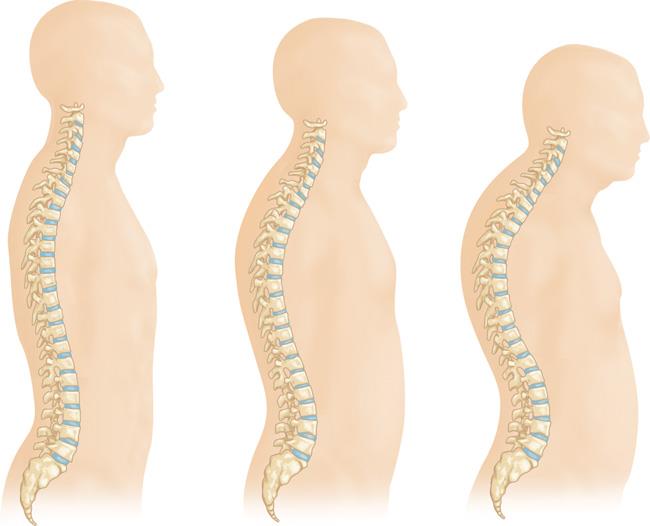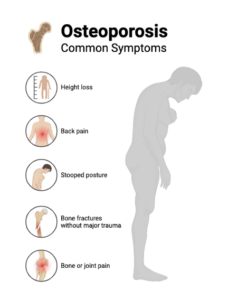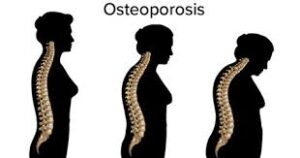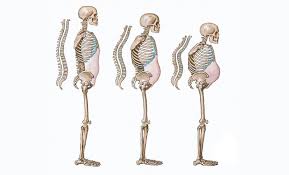

Osteoporosis, a condition characterized by reduced bone density and increased fragility, significantly impacts the musculoskeletal system.
While it is commonly associated with fractures, its effects on spinal curvature and head posture are often overlooked but equally critical.
The condition weakens vertebrae, leading to changes in spinal alignment and posture, which can significantly affect quality of life.
This article delves into the mechanisms behind these changes, supported by real-life examples and scientific research, to explore how and why osteoporosis alters spinal curvature and head posture.
Table of Contents
- Introduction to Osteoporosis and Its Impact on the Spine
- Understanding Spinal Curvature and Postural Changes
- 2.1. Anatomy of a Healthy Spine
- 2.2. Effects of Osteoporosis on Vertebral Structure
- Mechanisms Behind Spinal Curvature Changes
- 3.1. Vertebral Compression Fractures
- 3.2. Kyphosis Development
- Head Posture Alterations Due to Osteoporosis
- 4.1. Forward Head Posture and Its Causes
- 4.2. Associated Muscular and Functional Issues
- Real-Life Examples of Postural Changes in Osteoporotic Individuals
- 5.1. Case Study: An Elderly Woman with Kyphosis
- 5.2. Case Study: A Middle-Aged Man with Chronic Pain
- Conclusion
Introduction to Osteoporosis and Its Impact on the Spine
Osteoporosis is a systemic skeletal disorder characterized by low bone mass and deterioration of bone tissue, making bones more prone to fractures.
It predominantly affects older adults, especially postmenopausal women, due to hormonal changes that accelerate bone loss.
The spine, a central structure in the body, bears a significant load and is particularly vulnerable to osteoporosis.
This condition might lead to c2 vertebral compression fractures, which alter the alignment of the spine.
Over time, these changes result in exaggerated spinal curvature, such as kyphosis (a forward curvature of the upper back), and forward head posture.
These structural deviations are not just cosmetic concerns; they impair mobility, balance, and respiratory function, severely affecting an individual’s quality of life.
Understanding Spinal Curvature and Postural Changes
The human spine has natural curves—cervical, thoracic, and lumbar—that support balance and shock absorption.
Poor posture, prolonged sitting, or muscle imbalances can exaggerate or flatten these curves, leading to misalignment.
Forward head posture and rounded shoulders often shift the center of gravity, increasing strain on spinal structures.
Over time, these postural deviations can cause pain, reduced mobility, and even nerve compression.
Understanding spinal curvature helps in correcting posture and preventing long-term musculoskeletal issues.
Anatomy of a Healthy Spine:
The human spine is a remarkable structure designed for strength, flexibility, and balance.
It features three natural curves: the cervical curve in the neck, the thoracic curve in the mid-back, and the lumbar curve in the lower back.
These curves work harmoniously to absorb shock, distribute mechanical stress, and maintain the body’s alignment during movement and rest.
The spine consists of 33 vertebrae stacked like building blocks, with intervertebral discs acting as cushions between them.
These discs help absorb impact and provide flexibility for bending and twisting. Ligaments and muscles surrounding the spine ensure stability and support, while allowing a range of motion.
A healthy spine maintains an upright posture, enabling efficient movement and protecting the spinal cord, a vital communication highway between the brain and body.
Effects of Osteoporosis on Vertebral Structure:
In osteoporosis, the reduction in bone density weakens vertebrae, making them prone to compression fractures.
A study published in Osteoporosis International (Kanis et al., 2013) revealed that over 30% of individuals with osteoporosis experience at least one vertebral fracture.
These fractures often result in the collapse or “wedging” of vertebrae, reducing their height and altering spinal alignment.
This structural change leads to exaggerated thoracic curvature, or kyphosis, and compromises the natural balance of the spine.
Over time, these distortions contribute to noticeable changes in posture, including a forward-rounded back and compensatory adjustments in the head and neck to maintain balance.
This progression highlights how osteoporosis fundamentally disrupts spinal integrity.
Mechanisms Behind Spinal Curvature Changes
Your spine is not a straight rod—it is a dynamic, S-shaped marvel engineered for movement, balance, and shock absorption.
But when lifestyle meets gravity (think slouching over phones or hunching at desks), those natural curves begin to distort.
Scientific studies show that repetitive postural stress alters spinal loading patterns, leading to structural remodeling of vertebrae and discs.
Muscle imbalances, joint laxity, and poor ergonomics further drive these changes, making bad posture a self-reinforcing cycle.
Understanding these mechanisms is key to reversing postural damage before it locks your spine into dysfunction.
Vertebral Compression Fractures:
Vertebral compression fractures are one of the most defining complications of osteoporosis, resulting from the collapse of weakened vertebrae under normal loads.
These fractures typically affect the thoracic spine, which bears the weight of the upper body and is subjected to significant mechanical stress.
The vertebrae lose height when they collapse, leading to a “wedging” effect that disrupts the alignment of adjacent vertebrae.
Over time, this causes the spine to curve excessively forward, altering its natural shape and structure.
The cascading effect of multiple vertebral fractures not only impacts the spinal column but also triggers long-term complications.
A study published in The Journal of Bone and Mineral Research (Melton et al., 2006) revealed that individuals with vertebral compression fractures have a significantly higher likelihood of developing kyphosis—a pronounced forward curvature of the thoracic spine—and chronic lower back pain.
This combination exacerbates mobility challenges and further stresses the remaining vertebrae, perpetuating a cycle of structural damage.
Kyphosis Development:
Kyphosis, the excessive rounding of the upper back, is a common outcome of osteoporosis-related vertebral compression fractures.
As vertebrae weaken and collapse, the upper spine gradually curves forward. Severe cases of kyphosis are often referred to as a “dowager’s hump,” a visible sign of spinal deformity.
Beyond its impact on appearance, kyphosis has serious functional consequences.
A study in Spine Journal (Sinaki et al., 2005) highlighted that individuals with significant kyphosis experience reduced lung capacity due to compression of the chest cavity. This condition can lead to difficulty breathing and diminished endurance.
Additionally, the forward curvature shifts the body’s center of gravity, making it harder to maintain balance. This increases the risk of falls and subsequent fractures, creating a compounding cycle of injury and postural decline.
Kyphosis is therefore not just a cosmetic concern but a debilitating condition with far-reaching physical effects.
Head Posture Alterations Due to Osteoporosis
Osteoporosis does not just shrink bones—it subtly shifts your entire posture, especially how you hold your head.
As vertebrae weaken and compress, the spine loses height and curvature, often forcing the head into a forward-leaning position.
Studies in spinal biomechanics confirm that kyphotic changes in osteoporotic patients increase cervical strain and reduce gaze stability.
This altered head posture not only affects balance and breathing but also raises the risk of falls and neck pain.
Addressing bone density loss is crucial—not just for fracture prevention, but for keeping your head held high, literally.
Forward Head Posture and Its Causes:
The changes in spinal curvature caused by osteoporosis often lead to compensatory adjustments in head posture.
Forward head posture, where the head shifts anteriorly relative to the shoulders, is a common result.
This occurs as the body tries to maintain its center of gravity despite the altered spinal alignment.
Forward head posture increases the strain on cervical vertebrae and associated muscles, such as the sternocleidomastoid and trapezius.
Over time, this strain leads to discomfort and further postural instability.
A study in Clinical Biomechanics (Katzman et al., 2012) noted that individuals with osteoporotic kyphosis were more likely to develop forward head posture due to the biomechanical demands of maintaining balance.
Associated Muscular and Functional Issues:
Forward head posture is not just a structural issue; it has cascading effects on the musculoskeletal system.
The muscles of the neck and upper back are constantly engaged to support the forward-shifted head, leading to muscle fatigue, tension headaches, and chronic pain.
Additionally, poor head posture impacts daily functions such as swallowing, breathing, and even vision.
For osteoporotic individuals, these functional impairments significantly diminish their quality of life, as highlighted in a study published in The American Journal of Physical Medicine & Rehabilitation (Cummings et al., 2010).
Real-Life Examples of Postural Changes in Osteoporotic Individuals
I shall walk you through 2 case studies:
Case Study: An Elderly Woman with Kyphosis
Margaret, a 72-year-old woman, developed severe kyphosis following multiple vertebral compression fractures due to osteoporosis.
Over a decade, her posture gradually shifted, causing her upper back to round forward and her head to protrude.
She reported frequent back pain, difficulty breathing deeply, and challenges in performing everyday tasks like looking upward or reaching overhead.
Physical therapy focused on strengthening her back extensors and improving her posture, but the structural changes were irreversible.
Margaret’s case underscores the progressive nature of spinal and postural changes in osteoporosis.
Case Study: A Middle-Aged Man with Chronic Pain
John, a 55-year-old office worker, was diagnosed with early-stage osteoporosis after a routine check-up revealed low bone density.
Despite no fractures, his sedentary lifestyle and poor posture contributed to mild kyphosis and forward head posture.
He began experiencing neck pain and headaches, which were later attributed to the compensatory strain on his cervical spine.
Through a combination of weight-bearing exercises, posture correction, and ergonomic adjustments at work, John was able to prevent further deterioration and alleviate his symptoms.
His case highlights the importance of early intervention in managing osteoporosis-related postural issues.
What do You Learn from this Article?
Osteoporosis significantly impacts spinal curvature and head posture, primarily through vertebral compression fractures and the development of kyphosis.
These changes are not merely aesthetic but carry profound functional implications, affecting balance, respiratory function, and overall quality of life.
Forward head posture, a common compensatory adaptation, adds to the musculoskeletal strain and further complicates the condition.
Scientific studies and real-life cases illustrate the progressive nature of these changes and the importance of understanding the mechanisms behind them.
While osteoporosis may primarily be a disease of bone, its effects on posture and alignment remind us of the interconnectedness of the human body.
Early diagnosis, lifestyle adjustments, and targeted therapies can help mitigate these effects, ensuring a better quality of life for those affected.
References:


